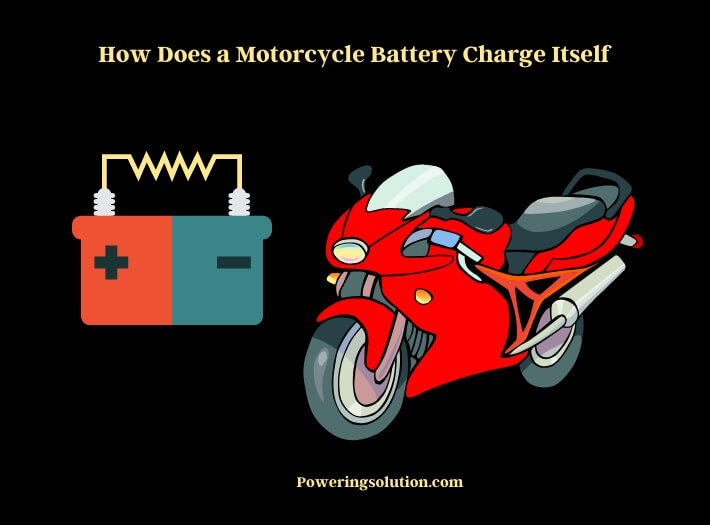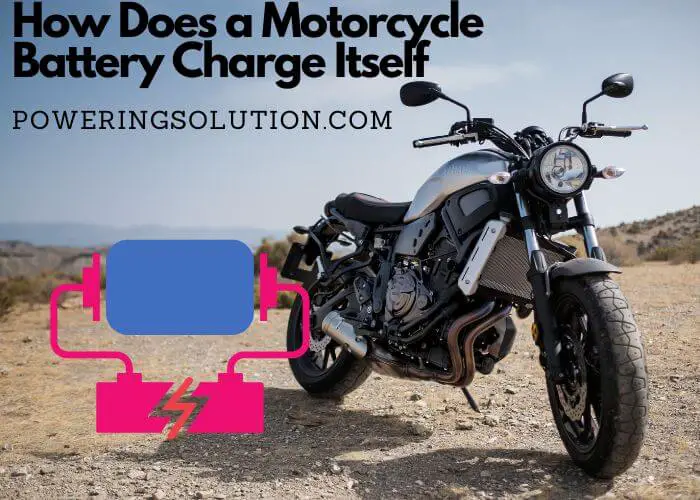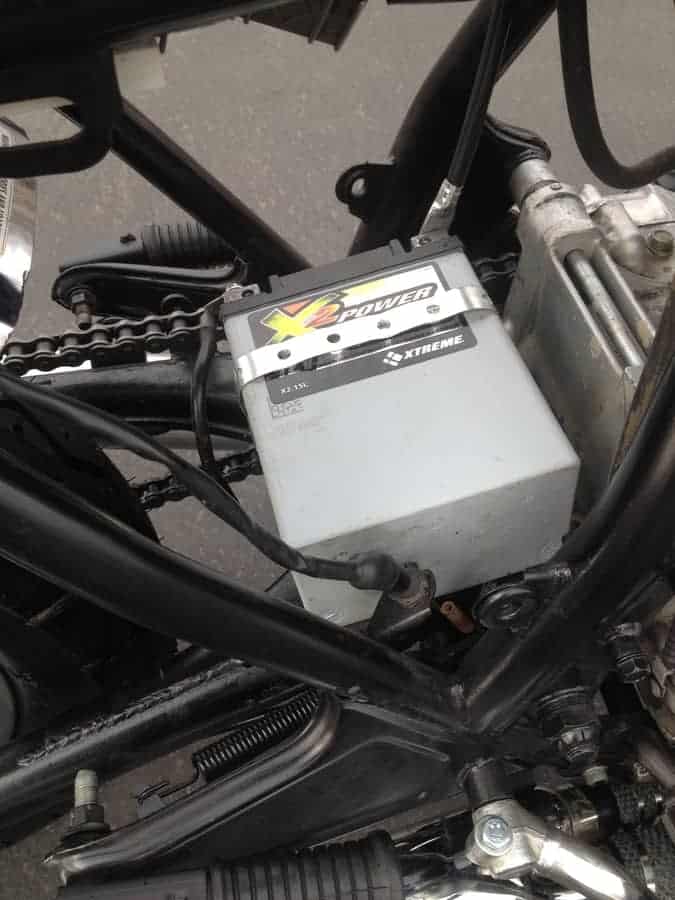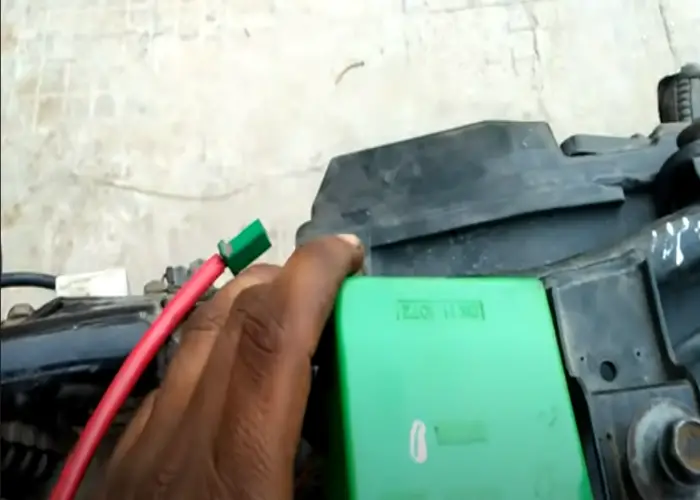Motorcycle enthusiasts, gearheads, and anyone with a keen interest in the mechanics behind the machines, gather ’round! Today, we’re going to unravel the mystery of the self-charging magic of motorcycle batteries. We’ll be delving into the nitty-gritty of how a motorcycle battery charges itself and what you can do to keep it in tip-top shape. So, let’s rev up our engines and dive right in!

The charging system on a motorcycle works like this: as the engine runs, it turns the alternator, which produces electricity. That electricity flows through the voltage regulator, which controls how much goes to the battery. The rectifier then changes that AC into DC so it can charge properly.
The Inner Workings of a Motorcycle Battery: A Quick Overview
Before we can understand the self-charging aspect of a motorcycle battery, it’s essential to get a grasp on the basics.
Types of Motorcycle Batteries
There are two primary types of motorcycle batteries:
- Lead-acid batteries (also known as conventional batteries)
- Maintenance-free batteries (such as AGM and gel cell batteries)
Both types have their pros and cons, but they all rely on a similar charging process. So, how does a motorcycle battery charge itself? Hold your horses; we’re getting there!
The Charging System: The Heart and Soul of a Motorcycle Battery
A motorcycle’s charging system is the key to understanding how a motorcycle battery charges itself. It’s a trio of components that work in harmony to keep your battery charged and ready to roll.
The Stator: The Coil that Generates Power
The stator is a stationary coil of wire responsible for generating alternating current (AC) when the engine is running. The stator’s magnetic field interacts with the rotor, which spins around it, generating electricity.
The Rotor: Spinning and Creating Magic
The rotor is a magnetic flywheel that spins around the stator. As it rotates, it generates a magnetic field, which, in turn, induces an electrical current in the stator’s coils.
The Regulator/Rectifier: The Traffic Cop of the Charging System
The regulator/rectifier serves two crucial functions:
- Converting AC from the stator into direct current (DC) for the battery
- Regulating the voltage to prevent overcharging the battery
The regulator/rectifier keeps a close eye on the battery’s voltage and adjusts the current flow accordingly. It’s a vital part of the charging system that helps ensure your battery stays in the green.
How Does a Motorcycle Battery Charge Itself? Connecting the Dots
Now that we’ve got a handle on the charging system’s components let’s see how they come together to answer the question: How does a motorcycle battery charge itself?

- When you start your motorcycle, the engine drives the rotor, causing it to spin around the stator.
- The spinning rotor creates a magnetic field, which induces an electrical current in the stator’s coils.
- The stator generates AC, which is then passed on to the regulator/rectifier.
- The regulator/rectifier converts the AC into DC and controls the voltage, ensuring the battery receives a steady flow of power without overcharging.
- The battery stores the energy it receives, effectively charging itself while the motorcycle is in operation.
And there you have it! The self-charging magic of motorcycle batteries, demystified.
Maintaining Your Motorcycle Battery’s Longevity
To keep your battery healthy and extend its life, follow these simple tips:
Regularly check the electrolyte levels in lead-acid batteries and top up with distilled water as needed.
Keep the battery clean and free of corrosion. A little baking soda and water can work wonders for cleaning terminals.
- Invest in a smart charger or trickle charger to maintain your battery when your motorcycle is not in use for extended periods.
- Ensure that your charging system is in good working order by regularly inspecting the stator, rotor, and regulator/rectifier.
Does a Motorcycle Battery Charge While Idling?
If you’re like most motorcycle riders, you’re always looking for ways to prolong the life of your battery. After all, a dead battery is the last thing you want to deal with when you’re out on the open road. So, does a motorcycle battery charge while idling?
The answer is yes and no.
| The answer is no because | If your bike has been sitting for a while, chances are the battery is already low on juice. |
| The answer is yes also because | However, if you’ve been riding regularly and stop for a long break (like at a red light), your bike’s alternator will continue to charge the battery while the engine is idling. |
Motorcycle Battery Not Charging While Running
If you have a motorcycle with a battery that’s not charging while running, there are a few things you can do to try and fix the issue.
| Causes | Fixes |
| Low voltage | First, check the voltage of your battery. If it’s low, try charging it with a trickle charger. |
| Damaged battery | If that doesn’t work, you may need to replace the battery. |
| The connection is broken. | Another thing to check is the connections between the battery and the motorcycle. Make sure they’re clean and tight. |
| Advanced damage | You may need to clean or replace them if they’re corroded. Finally, if none of these things work, you may need to take your motorcycle to a mechanic for further diagnosis. |
Motorcycle Alternator Output Voltage
Your motorcycle’s alternator is responsible for keeping the battery charged while the engine is running. The alternator’s output voltage can vary depending on several factors, but it should typically be between 13.5 and 14.5 volts. If your alternator puts out too much or too little voltage, it could cause problems with your motorcycle’s electrical system.
If you suspect your alternator isn’t working properly, take it to a qualified mechanic for diagnosis and repair.
How to Test Motorcycle Charging System

As the weather gets warmer and the motorcycle season approaches, it’s time to start thinking about getting our bikes ready for the road. One important maintenance item is to test the charging system to ensure it is in good working order. The charging system on a motorcycle has two main components –
- The stator
- The battery
The stator is responsible for generating electricity to charge the battery, while the battery stores power to run the electrical accessories on the bike. Both of these components need to be in good working condition for the charging system to function properly.
You can test your motorcycle’s charging system in a few different ways:
Digital Voltmeter
One is with a digital voltmeter. This will give you an accurate reading of voltage output from the stator.
Analog Voltmeter
Another way is with an analog voltmeter, which isn’t as accurate but can still give you a general idea of whether or not the charging system is working correctly.
Headlight Bulb
Finally, you can use a headlight bulb as a test light; if it lights up brightly when connected directly to the battery, the voltage is produced by the stator.
Once you’ve determined that the stator is producing voltage, it’s time to check the battery’s condition. If it’s more than three years old, chances are it needs to be replaced; even if it’s newer than that, yearly testing is still recommended.
Follow the step-by-step guideline to check the battery:
| Number of steps | Instruction to follow |
| First step | To test a motorcycle battery, remove it from the bike and hook it up to a charger (make sure you’re using one designed specifically for lead-acid batteries). |
| Second step | Let’s charge overnight, disconnect it from the charger and hook up the digital voltmeter again; you should see a reading of 12 volts or higher reading. |
| Third step | If not, then, unfortunately, the battery will need to be replaced as well. |
Motorcycle Charging System Wiring Diagram
Most motorcycle charging systems have three key components: the stator, rectifier/regulator, and battery.
- The stator is responsible for generating electricity as the engine runs. This electricity is then sent to the rectifier/regulator, which converts it into DC power and regulates the voltage going to the battery.
- The battery stores this power and provides it to the electrical system when needed.
Why is a Motorcycle Charging System Diagram Important?
A motorcycle charging system wiring diagram can be very helpful in troubleshooting any issues that may arise with your charging system. It can help you identify which components are not functioning properly and must be replaced.
A wiring diagram will also show you how these components are interconnected so that you can trace the electrical current through the system and pinpoint any areas where there may be a break in the circuit.
Motorcycle Charging System Troubleshooting
If your motorcycle won’t start, the first thing you should check is the charging system. A dead battery is the most common reason for a motorcycle not starting, and if your bike’s charging system isn’t working properly, the battery won’t stay charged.

There are a few things you can do to troubleshoot your motorcycle’s charging system:
Check the Battery
The first step is to check whether or not the battery is receiving power from the charging system. You can do this by using a multimeter to test the voltage at the battery terminals. If the voltage is below 12 volts, there may be an issue with the charging system.
Check the Charging System
If the fuse that protects your charging system has blown, it will need to be replaced before you can continue troubleshooting.
Check for Loose Connections
Ensure all of the connections in your charging system are tight and secure. Any loose connections could cause an interruption in power and prevent your motorcycle from starting.
Test The Regulator/Rectifier Unit
If you suspect that there may be an issue with your regulator/rectifier unit, you can test it with a multimeter to see if it is outputting power correctly.
Read more:
- Battery Charger For Semi Trucks: Things You Should Know
- Solar Charger For Marine Battery – Maximize Your Fun in the Sun
FAQs: Answering Your Burning Questions about Motorcycle Batteries
How long does a motorcycle battery last?
The lifespan of a motorcycle battery typically ranges from 2 to 5 years. However, this can vary depending on factors like maintenance, usage, and environmental conditions.
Can I jump-start a motorcycle battery?
Yes, you can jump-start a motorcycle battery using another motorcycle or a car. However, take caution when using a car; make sure its engine is off to avoid damaging the motorcycle’s electrical system.
How can I tell if my motorcycle battery is dying?
Some common signs of a dying battery include difficulty starting the engine, dimming headlights, and loss of power to accessories like the horn or turn signals.
What should I do if my motorcycle battery keeps dying?
If your motorcycle battery keeps dying, it’s essential to first rule out any issues with the charging system. Check the stator, rotor, and regulator/rectifier for any signs of wear or damage. If the charging system is functioning correctly, it may be time to replace the battery itself.
Does a Motorcycle Battery Self-Charge if it is Drained?
Yes, a motorcycle battery drainage can be recharged if it is drained, but it depends on the type of battery. Conventional lead-acid batteries may not self-recharge if drained completely, while modern lithium-ion batteries may have some self-recharge capability. Regular recharging is the best practice to maintain battery health.
End Note: The Self-Charging Magic of Motorcycle Batteries Revealed
And there you have it, folks! We’ve uncovered the mystery behind how a motorcycle battery charges itself, explored the crucial components of the charging system, and even shared some tips on maintaining your battery’s longevity. With this newfound knowledge, you’re well-equipped to keep your motorcycle’s battery in peak condition, ready to hit the open road whenever adventure calls.
Remember, a well-maintained battery is not only essential for a smooth ride but also for your safety. So, the next time you’re tinkering with your motorcycle, give your battery some extra love and care, and it’ll return the favor with years of reliable service. Happy riding!
Relevant Resources:
